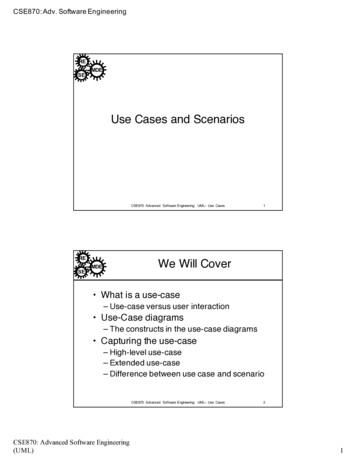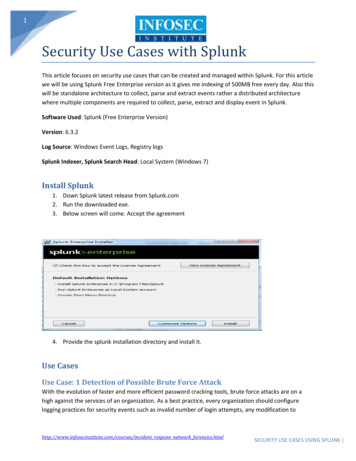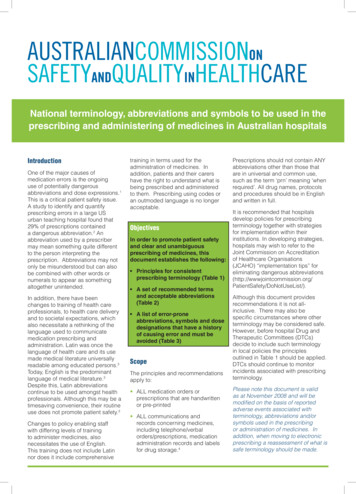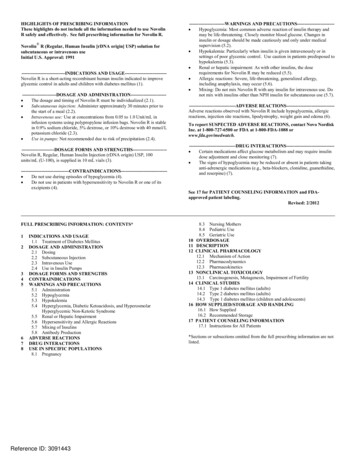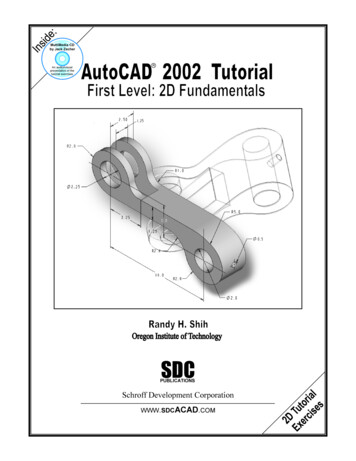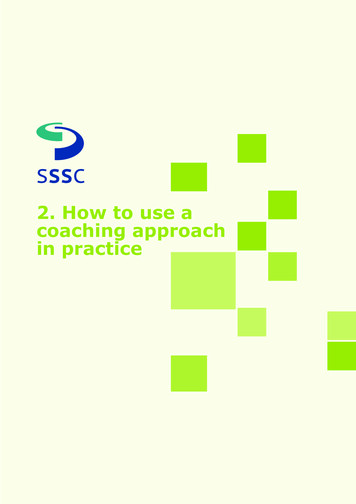
Transcription
2. How to use acoaching approachin practiceCoaching Learning Resource 19
In this section we cover in more detail what is involved in coaching in practice in socialservices.1.2.3.The values and behaviours of all those involved in a coaching approach.The core skills needed for a coaching approach.The scope of an informal coaching conversation and how to manage it well.Each of these elements is involved in the different applications of coaching frominformal to more formal as outlined in table 1.Applicationof coachingapproachAn informalcoachingconversationWho isinvolvedTwo or morepeopleWhat isinvolvedPositive intent, core values and behavioursCore coachingClarity aboutpurpose ofconversationCoachingin linemanagementrelationshipIndividualworker andline managerskillsClarity aboutpurpose ofcoaching incontext oflinemanagementrelationshipCoaching chingof a teamLeader,colleaguesandstakeholdersCoachee andinternal orexternalcoachTeam orgroupand oneor morecoachesApplication ofcore coachingmodel(s) orapproachesApplicationof teamcoachingmodelAlignmentwithprinciples ofcitizen andcollaborativeleadershipTable 1: Who and what is involved in different types of coachingThere is more information about the practice of formal coaching and the application ofdifferent coaching models in section 3.After reading this section you will be able to: describe the skills and knowledge needed to practise a coaching approacheffectivelyanalyse your own capabilities to identify areas of strength and areas fordevelopment in relation to developing an effective coaching approachname a number of different practical tools for coachingidentify the most relevant tools for your own practice and show how theycould be used.20 Coaching Learning Resource
2.1 Values and behaviours of all those involved in acoaching approachThe quality of the space created in a coaching conversation can help people makesense of their situation and clear choices about what to do next. The people involvedin a coaching approach create this space through their behaviours and values.These behaviours and values are described in a set of core principles. The principlesare as relevant to those involved in informal coaching conversations as those takingpart in a formal coaching relationship. There is a strong link between the core valuesof social services and these principles of the practice of coaching. The bold wordsbelow demonstrate the potential link with core social service values. The person being coached is resourceful. They have the potential resources andthe capabilities within them to work on their own issues and resolve their ownproblems.The role of the coach is to enable the person to draw on their ownresources. This means helping them develop their own awareness and insights,take responsibility and exercise choice in finding their own solutions.Coaching considers the whole person enabling them to understand andappreciate their strengths as well as their areas for development from all partsof their life and make sense of their past or current achievements and challenges.The person being coached sets the agenda enabling them to focus on what isconcerning them within the context of the service or their area of work.The person coaching and the person being coached are equals. Coaching isnon-directive, non-judgemental and it relies on mutual trust and respect betweenthose involved in it.Coaching is about change and action. The person seeking coaching wantssomething to change and the role of the coach is to help them achieve thisself-improvement or skills development. Ultimately coaching is about helpingpeople develop their own ability to coach themselves.(Jenny Rogers, 2004)There is also a strong link between the principles of coaching and citizen leadership: taking responsibilitybeing enabled to exercise choicerealising your potentialfocusing on your own developmentbeing involved in understanding and resolving your own issuesbeing person-centred.What do the values look like in practice? When you engage fully in a coaching approach you have a positive intent aboutthe other person (or people).Coaching Learning Resource 21
You have a belief in their resourcefulness and their potential to make sense oftheir own situation.You believe they can find their own solutions. Your intention is to help them findtheir own solutions and make their own choices about their course of actionfollowing the coaching conversation.Your relationship with others in a coaching approach is based on trust and mutualrespect.You remain curious about their issues and concerns and seek to understandmore about their perspective.You are open and honest in your interactions. If there is something which is notclear to you or you do not understand, you ask more about it rather than jumpingto your own conclusions.You strive to be non-judgemental of the other people, their issues and concerns.You are prepared to see the situation from the other person’s point of view. Inother words, you demonstrate empathy rather than sympathy.What do the behaviours look like in practice? In a coaching approach, you attend to the other person (or people) involved.This means that you are fully present and not distracted by your own concernsor priorities.You listen carefully and you demonstrate openly that you are listening.You are committed to building rapport. You understand that building andmaintaining rapport is a critical foundation for an effective coaching approach.You are self-aware. This means you are aware of the impact of a coachingconversation on you. You are able to manage your reactions carefully, remainingpresent in the conversation and attending to others in the coaching conversation.You are supportive to others involved in the coaching conversation. You create thespace in which they can talk openly about their issues and concerns without fear ofjudgement or censure.While you are supportive, you resist the temptation to jump in and solve others’problems. In a coaching approach, it is not your responsibility to rescue the otherperson. You believe in the resourcefulness of the other person even thoughit may be tempting to make it better for them. You understand that when we areenabled to reach our own insights and find our own solutions, we are more likelyto take action and the impact is more sustainable.You are able and prepared to challenge constructively with the positive intentionof supporting the other person’s own exploration of their issues and challenges.You do not shy away from giving honest feedback in the moment. But you aresensitive in how you provide this feedback consistent with the principlesof coaching.You manage yourself carefully in a coaching approach. You are honest and openabout your own professional competence and its boundaries. In other words,you recognise when there are issues beyond the scope of a coaching conversationand highlight this to everyone involved.22 Coaching Learning Resource
2.2 Core skills needed for a coaching approachThere is a core set of coaching skills whether it is as part of an informal coachingconversation or a formal coaching approach. The skills are built upon the foundationof the values and behaviours for coaching (described above). Attending to the other person involved in a coaching approach, building rapportwith them and seeking to understand what is going on for them.Listening actively and carefully to the other person and paying attention to whatthey are saying and how they are saying it.Summarising or paraphrasing what the other person has said as a way ofhelping them reflect on their own situation, rather than giving advice or addingyour own judgement.Using open questions which encourage the other person to say more, to reflectand understand more about their own situation.Being prepared to give honest, clear and specific feedback while makingsure the relationship stays positive and open.AttendingAttending to the other person (or people) involved in a coaching approach meanskeeping your full attention on the other person. This is important for conveyinggenuine interest in them and their issues. It is an important foundation for buildingrapport and looking to understand what is going on from their point of view.It can be challenging to attend to what someone else is saying and how they arefeeling without being overtaken by our own thoughts and feelings.Here are some guidelines on how you can stay present and attend to someone elseduring a coaching conversation so you are able to concentrate fully on what they aresaying and not saying. Before a conversation spend a few minutes sitting quietly. Quieten your mindand your own issues and concerns so you feel ready for the conversation and fullyattentive to the other person (people).During a conversation try to remain calm. If you notice your calmness slippingaway, take some deep breaths and consider taking a pause in the conversation.This will help you regain your sense of calm and focus on the other person.Make sure you distinguish between your own reactions or emotions and those ofthe other person.Find a balance between being objective and showing empathy for the issues beingexpressed by the other person.Make it clear to the others involved that they are always in charge of choosingwhat they want to express.Avoid the temptation to make lots of notes. Notes can get in the way of beingwith the other person, really hearing what they are saying and our relationshipwith them.Coaching Learning Resource 23
Notice if your mind is racing ahead to thinking of a solution or making ajudgement. Jumping to your own conclusions or solutions will distort yourlistening. Ultimately you will be more helpful to others if you enable them to reachtheir own conclusions and find their own solutions.After a conversation notice what happened to you in the conversation. Listen toyour own curiosity and intuition. Consider developing your ability to be aspresent as possible by cultivating a practice in mindfulness, yoga or some otherapproach that supports the ability to be more aware of what is happening in ourminds and bodies. If you are interested in reading more about the use ofmindfulness in coaching see Mindful Coaching by Liz Hall (Liz Hall, 2013).Exercise for attendingFind someone to have a coaching conversation with you. Be clear that you areusing this conversation as a way of developing your own coaching skills.Be aware of how you are as you start the conversation.Write down your thoughts and feelings.Note any barriers that prevent you from listening actively.At the end of the conversation, discuss with your coachee how you bothexperienced your listening during the conversation.How did the coachee experience your attending and listening to them?Identify the moments when you thought there was a difference between whatwas being said and the feelings you were sensing from the coachee.Check out your views with the coachee.ListeningAll interactions with other people rely on listening. We all know that the quality of ourlistening can vary. Active listening is essential to an effective coaching approach.‘To be listened to is a striking experience, partly because it is so rare. Whenanother person is totally with you – leaning in, interested in every word,eager to empathise – you feel known and understood. People open up whenthey know they’re really being listened to; they expand; they have morepresence. They feel safer and more secure as well, and trust grows. That iswhy listening is so important to coaching ’(Laura Whitworth et al, 2007, p31)Being committed to listening in a coaching conversation means you pay closeattention to the verbal and the non-verbal cues of the person speaking. Our bodylanguage and voice convey a lot of meaning. When there is inconsistency between24 Coaching Learning Resource
the words someone is using and their body language and tone of voice, it is likely thereal meaning is being conveyed in the non-verbal cues.For example:A colleague says she is happy about taking on a new role in her team. Buther facial expression and tone of voice seem to convey a different message.At that point, you might say: ‘You said you’re happy to take on this newrole, but your face and voice seem sad. I’m wondering what you really thinkabout it’. This gives the colleague a chance to share her real feelings if shechooses to do so.As a coach, you need to use all your senses when listening. You need to be preparedto offer observations about what you see as well as the discrepancies with what thecoachee is actually saying. As a committed listener, you leave space for the otherperson to speak and to reflect on your question before speaking. You resist thetemptation to jump in and give your opinion or piece of advice.By noticing everything the coachee is saying and how they are saying it (or notsaying it), you offer them the opportunity for a much deeper level of understandingand insight into what is going on. In this way, the skill of attending is closely linked toeffective listening.What can get in the way of active listening? We all have an inner voice that causesus to be distracted. Sometimes this inner voice is distracted by thinking about anevent which has affected us. Sometimes it is throwing in our own fears, concerns orjudgements. Whatever the inner voice is saying it can be an interruption to our abilityto listen fully and actively to another person.Exercise for listeningThink about some of your own personal barriers to listening.Practice noticing body language, facial expressions and tone of voice in others.When you feel comfortable, try offering observations if you think that their bodylanguage, facial expressions or tone of voice are at odds with what they areactually saying.There are different levels of listening. In their approach to coaching, Laura Whitworthand her colleagues describe three levels of listening (Laura Whitworth et al, 2007). At level 1 our awareness is on ourselves. The purpose of information gatheringat this level is to meet our own needs. It informs us about ourselves and what isgoing on around us. In a coaching conversation, the coachee is mainly listening atlevel 1. The coach aims to listen mainly at levels 2 and 3 and needs to be carefulabout slipping back into level 1.Coaching Learning Resource 25
At level 2 we have a sharp focus on the other person. In a coaching conversationthe coach’s awareness is totally on the coachee. The coach listens to their words,their expressions, their emotions. They notice what they are saying and how theyare saying it. They notice what they are not saying. Listening at this level meansyou also need to be aware of how you respond to what you have heard and howyou leave space for them to react to your response. At level 3 you are also listening to your intuition. It can be described asenvironmental listening. It means going beyond what you are hearing and trustingyour senses.Exercise for listening at levels 1 and 2 The aim of this exercise is to experience what it is like to listen completely at level1 and then at level 2.It will allow you to compare and contrast the two levels of listening.It will provide a practical experience of the differences, advantages anddisadvantages of these two levels of listening.Part one Describe level 1 listening to someone.Ask them to describe a trip they have taken including stories about things thatwent well and things that did not go so well.As they tell you the story, your job is to listen to the words and interpret the storyentirely in terms of your own experience. Make frequent comments which offeryour opinion. Think about what you would have done differently or how you mightimprove their story.What is happening for you while the other person is talking? What are youthinking about and how are you feeling?What does the story remind you of in your own life?After 10 minutes, tell each other what it was like to listen and be listened to atlevel 1.Part two Work with the same person and the same story for another 10 minutes but thistime be curious (without describing level 2 listening), asking questions, clarifyingand articulate what you see.Be alert for the other person expressing their values in the story. Stay completelyfocused on them by listening and responding at level 2.After 10 minutes, tell each other what it was like to listen at level 2 and what itwas like to be listened to at level 2.How was the experience different from level 1 listening?Source: Laura Whitworth et al, 2007, pages 47-4826 Coaching Learning Resource
A sign of good listening is that the coach picks up on the coachee’s choice of wordsand uses them to reflect back. This is one of the simplest yet most profound skills incoaching. Reflecting means you replay some of the coachee’s words back to them sothey can add to them or explore further.It can help by: letting the coachee know they have been heardconfirming for the coach they have correctly understood what the coacheeis sayingchallenging the coachee gently to explain further or say more about the issue.It does not matter if the coach is inaccurate as long as the reflection is offered in aspirit of curiosity and a desire to understand. It simply enables the coachee to refinethe reflection and it gives the coach a clear steer on what is important and significantfor the coachee.The skill of reflecting lies in the timing and choice of phrase to replay. It is best towait for the coachee to pause and then reflect back the chosen words or phrase.Summarising and paraphrasingSummarising is a skill that allows the coachee to pause for thought. A summary doesnot have to capture everything the coachee has said. It draws out the main themes inthe conversation as those are what matter.Summarising is a shared activity. The coach draws out the key themes for thecoachee to verify and build upon. The skill in summarising is the time and method.It is best to wait for a natural break before offering a summary but sometimes, ifinformation is coming thick and fast, it is helpful to interrupt gently and suggest asummary might be beneficial.It is best if the coach indicates a summary is about to happen as shown in thefollowing examples. ‘Can I check what I think we have covered so far? You mentioned ’ (thensummarise the key themes).‘I would like to make sure that I have heard what you have said so far. I believeyou mentioned ’ (then summarise the key themes).‘I wonder if I could check in with you. Am I right in thinking that you havediscussed ’ (then summarise the key themes).Once the coach has offered a summary, it is crucial to leave space for the coachee toverify the summary and add to it if they want.Summarising helps those who think aloud explore lots of points along the way byconnecting them back to the key points of what they want to cover in coaching.Coaching Learning Resource 27
Summarising helps those who think first before speaking by showing they have beenheard and understood. Summarising helps the coachee think further and deeper aboutwhat they are sharing in the coaching.Sometimes people have a lot to say in a coaching conversation. It might be the firsttime they have been given the space to fully explore their issue. In this case it mightbe better to invite the coachee to do their own summary as shown in the followingexamples. ‘There seems to be a lot in what you just said. What would be the main highlightsfor you?’‘You seem to have thought about this a lot. If you were to pick out the headlines,what would they be?’It can also be helpful for the coach to add to the coachee’s summary. ‘I think I picked up another point in addition to your summary. I wonder whether Icould check it out with you.’Offering a summary or inviting the coachee to give a summary is helpful to thecoachee. It remains the coachee’s choice which key themes they spend more time onin the rest of the coaching conversation.Paraphrasing is a short statement or summary of what another person is saying.It helps the coachee clarify their thinking. By doing this without giving advice orinterrupting with your own judgement or story, the coach will deepen the level oftrust. Paraphrasing actively demonstrates you are fully listening to the other person,you care about what they are saying and you are trying to understand their point ofview.Exercise for summarisingPractice your skill of summarising by listening out for the key threads, elementsor issues in what a colleague is saying.At a suitable pause, ask their permission to provide a summary.Mention the number of points you are summarising followed by your briefsummary of these key points.Check the summary represents a shared understanding of what your colleaguehas said. Leave space for your colleague to confirm the summary is accurate orto reframe your key points in a way which makes sense to them.28 Coaching Learning Resource
Watch this brief video Improve your listening skills with active listening byMindTools on YouTube.For a perspective on the importance of listening, especially within the contextof negotiating and managing conflict, watch this TEDx Talk‘The power of listening’ by William Ury (2015) on YouTube.Using open questionsA key skill for coaching is asking effective and open questions. The purpose of askingquestions in a coaching conversation is to encourage the other person to say more, toreflect and understand more about their own situation.Effective questions flow from your ability to listen actively. Sometimes the mosteffective way of enabling someone to explore their issue or concern is simply toencourage them to say more: ‘tell me more about that’‘say more ’‘what else do you want to say about that?’.There are some key points to remember about asking questions.Ask simple questionsSimple questions are short questions that usually start with what, how, where, who orwhen. Questions starting with what and how are most common, for example: what would success look like for you?how would you know that you have achieved your goal?where else in your life have you achieved something similar?who do you need support from to help you achieve your goal?when did you last celebrate your achievement?.Ask one question at a timeIf you are part way through a question and start adding to it, it will become toocomplicated and confusing. Trust your original question and stick with it. If the otherperson does not understand the question, let them tell you and you will have theopportunity to rephrase it.Coaching Learning Resource 29
Ask fewer questionsThe fewer questions we ask, the more space we provide for the coachee to think andreflect on their answers. Think about the quality and purpose of each question ratherthan the number of questions. Sometimes it can be more powerful to leave space forthe coachee to think before speaking. Staying quiet and leaving silence for thecoachee to reflect can be a more powerful intervention than another question.Ask questions to help the other person discover moreIn everyday conversations, we ask questions that help us understand better (tosupport our level 1 listening). In coaching conversations, we ask questions to helpthe coachee understand more about their own situation. The question should followthe interest of the coachee; it should emerge from what the coachee has just said.These questions help the coachee discover more about their own situation.Ask questions that balance support and challengeFor coaching conversations to be effective we need to find the right balancebetween support and challenge. Too much support and we might as well be havinga good discussion with a friend or partner. Too much challenge and the coachingturns into an inquisition.Supportive questions are asked in an understanding way and will help the coacheeunderstand more about what is going on for them. Challenging questions aremore probing. They look to get at what is going on behind the issue, verify thefacts and enable the coachee to discover further options. Challenging questionsneed to be asked in a way that conveys possibility and the coach’s belief in theresourcefulness of the coachee.Watch this short video about powerful questions by Professor David Clutterbuck(shared on YouTube by Horizons Unlimited).See resource 1 for practical tools and tips on the use of questions in coaching.Questioning styles to avoid in coaching conversationsThere are no bad questions as long as the coach leaves space for the coachee toreframe the question.However, there are some styles of questioning to avoid in coaching conversations.30 Coaching Learning Resource
Asking closed questionsClosed questions typically produce a yes or no answer. In the main, closed questionsare unhelpful in coaching as they do not move the issue forward. A coachingconversation aims to help the person understand more about their own situation andfind their own solutions. Questions which are open and thought provoking are morelikely to support this kind of exploration.Leading questionsCoaching is about helping the person understand more about their own situationin their own way. A question which leads the coachee to a particular point of viewwill not help their thinking. A leading question is one which contains a suggestedanswer, for example: ‘How did you feel about that – upset?’Rephrasing rather than re-using the coachee’s own wordsA sign of good listening is that the coach picks up on the coachee’s choice of wordsand uses these words to reflect back. But if the coach rephrases what the coachee hassaid rather than using their words, it can cause the coachee to lose their train ofthought.Questions that break rapportHow a coach asks a question is as important as the question itself. For example, if acoach has been asking supportive questions and then suddenly uses a challengingquestion without any warning, this risks breaking the rapport between coach andcoachee. In this case, it would be better to signal a move to a more challengingquestion: ‘I wonder if I could ask you a more challenging question at this point?’.Too much of the why questionThe danger with questions which begin with the word why is that they can result in adefensive response. When asked why, the other person typically feels they have tofind reasons to justify their action. Sometimes this is to do with the tone in which thequestion has been asked. In a coaching conversation it is usually best to change awhy question to a what question. ‘Why did you do that?’ becomes ‘What was your thinking behind that?’‘Why did you feel that way?’ becomes ‘What led you to feel that way?’Being prepared to give honest, clear and specific feedbackWe all need feedback to grow and learn by understanding more about our impact onother people. Being prepared and able to give honest, clear and specific feedback is acore skill in coaching. It is important that feedback is given in a way which makes surethe relationship stays positive and open.Coaching Learning Resource 31
In the context of a coaching conversation, the coach provides feedback in the momentand in response to what they are experiencing about the coachee. This kind offeedback can be helpful to the coachee because it might reflect something about howothers are experiencing them.Watch Meg Wheatley talking about the importance for leaders of seeking andhearing honest feedback. Let go and lead: Meg Wheatley – leadersneed honest feedback (on YouTube).2.3 The scope of a coaching conversation and how tomanage it wellIn an informal coaching conversation, you do not need to have an expertunderstanding of the other person’s role or context. In fact, it can be helpful if thecoach works in a different field or comes from a different perspective. If you do workin the same field or system, it is important to be open about what this might mean forhow you engage in a coaching conversation.In any kind of coaching conversation, it is important to be aware of the limitationsof your own professional competence and the boundaries around the conversation.In formal coaching, the coach is bound by ethical practices which include knowingwhen to refer someone for other professional support (for example counselling) ordevelopmental support.In informal coaching conversations, there are some simple guidelines for preparingfor and managing the conversation. See resource 1 for further tools and tips aroundmanaging coaching conversations well.Clarity of purposeMake sure everyone involved in the coaching conversation is clear about its purpose.You could ask: ‘what are we hoping to achieve by having this conversation?’‘what is the background and context for this conversation?’‘what would a good outcome from this conversation look like?’.Clarity of scopeMake sure everyone is clear about the scope of the conversation. You could ask: ‘who is involved in this conversation?’‘what are the roles of each person involved in the conversation, eg coach,coachee, co-coach?’‘what are the boundaries of this conversation and how will we collectivelymanage these boundaries?’.32 Coaching Learning Resource
Manage the processThink about how you are going to manage the coaching conversation. You could usea simple framework such as: beginnings, middles and endings.Begin the conversation clearly and wellMake sure everyone understands their roles and responsibilities in the coachingconversation. Agree some ground rules about how you are going to work togetherin the coaching conversation, paying attention to the values and behaviours forcoaching. Give the coachee space to set out the issue they wish to explore in thecoaching conversation.Pay attention to what the coachee needs from the conversationManage the conversation carefully making sure the coachee has enough time andspace to explore their coaching issue. Attend to the balance between supportand constructive challenge. Notice and pay attention to the patterns in theconversation. Enable
mindfulness in coaching see Mindful Coaching by Liz Hall (Liz Hall, 2013). Exercise for attending Find someone to have a coaching conversation with you. Be clear that you are using this conversation as a way of developing your own coaching skills. Be aware of how you are as you start


